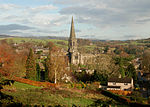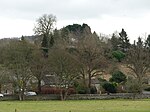Bakewell Urban District
Derbyshire geography stubsDistricts of England abolished by the Local Government Act 1972Districts of England created by the Local Government Act 1894History of DerbyshireUnited Kingdom government stubs ... and 1 more
Urban districts of England

Bakewell was an Urban District in Derbyshire, England from 1894 to 1974. It was created under the Local Government Act 1894. The district was abolished in 1974 under the Local Government Act 1972 and combined with various other local government districts in western Derbyshire to form the new West Derbyshire district.
Excerpt from the Wikipedia article Bakewell Urban District (License: CC BY-SA 3.0, Authors, Images).Bakewell Urban District
A6, Derbyshire Dales
Geographical coordinates (GPS) Address Nearby Places Show on map
Geographical coordinates (GPS)
| Latitude | Longitude |
|---|---|
| N 53.213 ° | E -1.6759 ° |
Address
A6
DE45 1BT Derbyshire Dales
England, United Kingdom
Open on Google Maps











